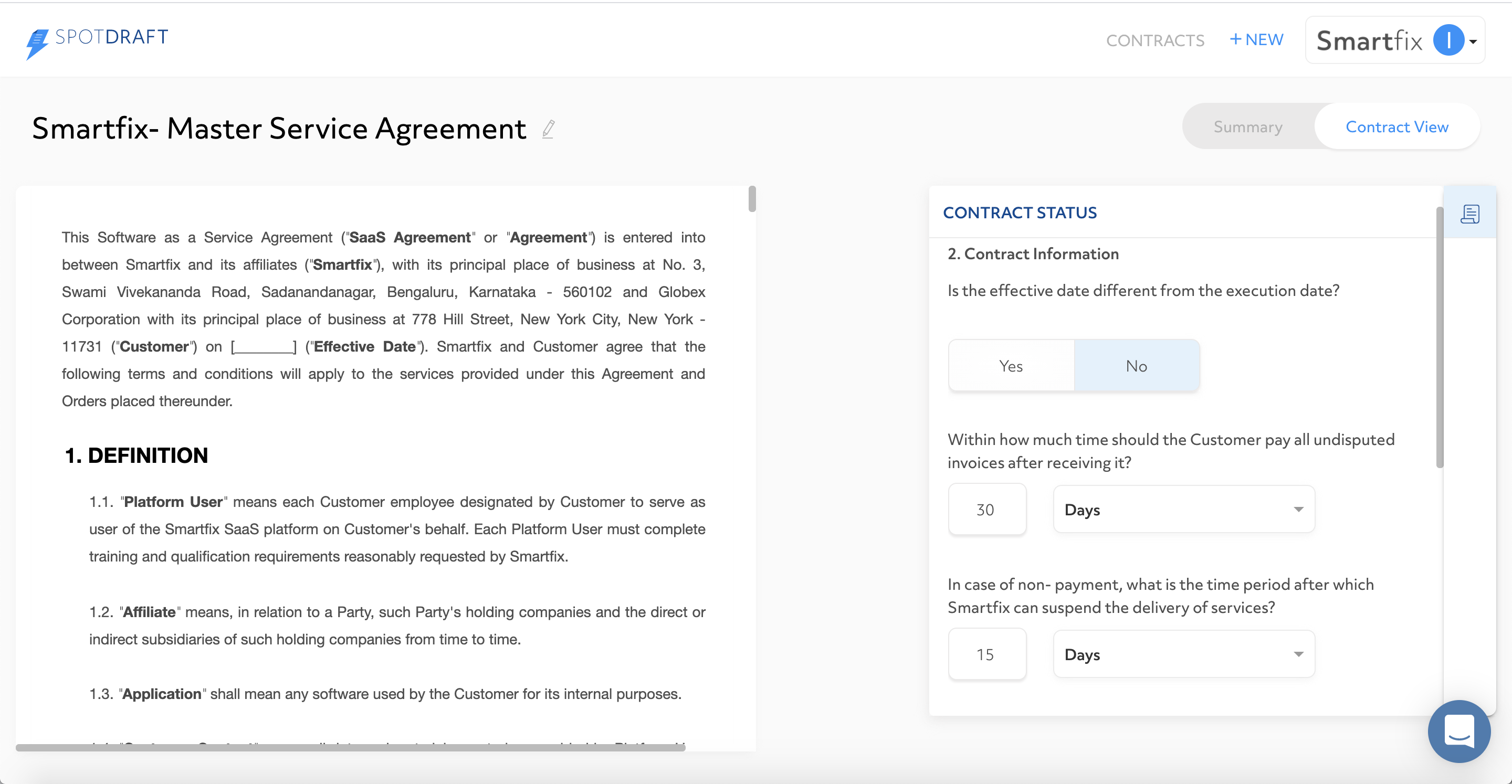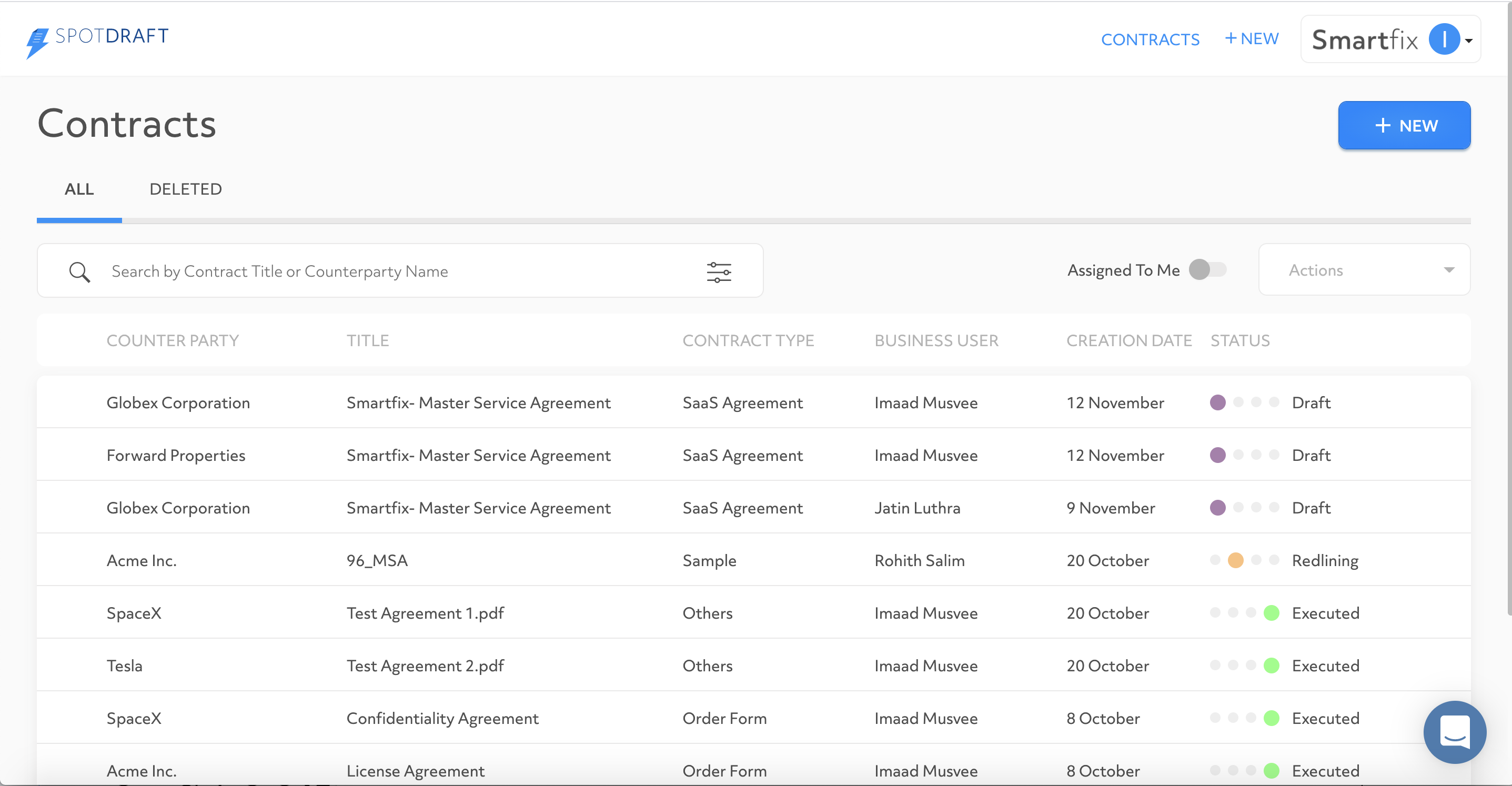SpotDraft is an end-to-end contract management platform for in-house lawyers across teams of all sizes. It gives corporate lawyers the power to offload mundane contract work to machines, save time and money, enrich the quality of everyday work for lawyers, and reimagine the notion that in-house legal teams are a cost function.
The editors of Legal Tech Asia recently spoke with Shashank Bijapur. He is the co-founder and CEO of SpotDraft, who took us through SpotDraft’s ubercool contract management mechanism, and his experience in building, scaling, growing, and helping legal teams realize their human potential by leveraging technology.
Could you share your experiences with our readers? How did you conceptualize SpotDraft?
I started as a lawyer in India and then completed my Master’s at Harvard Law. Focused on the lock-step to becoming a partner, I then joined a white-shoe law firm.

There is an industrial gap between what you’re taught in a law school versus the skills you eventually employ in the industry. Law school taught me that any work needed to be given proper attribution, that originality was not only rewarded but also expected as decorum. Now at the firm, we were asked to work off precedents and templates. Firstly, to minimize errors in the process, and secondly to expedite the process itself. Naturally, a lot of tasks were very repetitive.
No aspiring lawyer joins academia to learn how to copy and paste one document into another. Then again, no company wants each contract to go through a protracted legal review or have different clauses. Despite these repetitive tasks not adding value to a lawyer’s everyday life, they were still an integral part of the process.
Having witnessed this problem first-hand, I realized that there was a need to help lawyers overcome their everyday burden of repetitive tasks and focus on adding value to their workplaces without compromising the process. That’s when I saw the opportunity to put contractual work on autopilot so to expedite the process without compromising on quality.
How does SpotDraft help automate work? What features do you currently offer?
If you ask any lawyer what their topmost concern at work is, you’d immediately be given a lesson in the challenges of creating and maintaining endless piles of contracts. And it is not just them. Most business teams hate contracts – firstly because they are extremely sensitive and will strain your eyes, and secondly because they are time-consuming.
We aim to resolve contract-related troubles not only for lawyers but for any team within an organization even remotely having to deal with them. Think of SpotDraft as a brain for your contracts that can effectively draft and organize themselves with just an input of a few key details.
Traditionally, lawyers have been made to use a library of tools just to create, share, and sign contracts. A spreadsheet or word document to store contract templates or clauses, another word document to create a contract, a series of emails to send that for review and receive edits, and finally, after a zillion iterations and versions of the same document, an eSignature tool to get it signed from the counterparty.
At the end of the day, you are not only creating a contract, but you are also mining for a specific version created a week ago to find that one specific clause or definition that you now need. SpotDraft does all of that and more, but from one easy-to-use interface and within the click of a few buttons.
Our platform helps you draft, edit, manage, analyze, and even execute contracts all through one intuitive interface.
All your imported contracts are automatically arranged within an intuitive library. Each is automatically tagged with relevant metadata so users can search and identify across any stage in their workflow, at any time.
However, one of our most exciting feature rollouts has been the purpose-built editor for contract review. While many still rely heavily on MS Word, word processors weren’t really tailored to the sensitive use-case of lawyers. Sure, they can iron out the occasional grammatical inconsistencies, but they don’t proactively contribute to the contract drafting process.

SpotDraft’s in-line editor is the only tech implementation of its kind that not only highlights errors, definitions, or unaddressed clauses in your contract but also provides edit suggestions. All clauses in the contracts generated are dynamic and automatically readjust in case any key detail (e.g. entity name and location) changes.
Any iterations made to a contract, their time-stamps, and records of the editors are auto-logged behind the scenes. And even if the changes are made within a word document beyond our ecosystem, they are incorporated and reflected in your existing contracts on SpotDraft as soon as you upload them. This means no – “hopefully_last_and_final_version_NDA2.91.docx.”
SpotDraft also features its own, free eSignature tool so you don’t need to worry about buying into a separate product just to get your contracts signed. We are also currently working on a bevy of other features to give corporate contracts superpowers!
How are you currently placing yourself in a highly competitive legal technology market?
While it is true that the legal technology competition is on the afterburners, it is also true that the market remains highly fragmented. A majority of tools own a part of the process really well, but there is a consensus that very few tools are supporting a lawyer throughout entire life cycles in their everyday task.
While many tools either conduct contract analysis or provide contract management and inventorization. And I already mentioned that using different tools for different segments in the same process can lead to loss of data. It is also equally inconvenient and time-consuming.

At SpotDraft we spotted the opportunity to provide lawyers an all-encompassing solution that is designed to maximize productivity without compromising on the quality of work. SpotDraft’s repository of contracting features straight from drafting, redlining, or collaborating, to execution, inventorization, and analysis, helps lawyers accelerate their workflows without having to reinvent their process wheels.
What has your journey so far looked like? How have you tackled the pandemic?
The previous year has been great for business but tough on the team. We were in the early stages of a hiring sprint when the pandemic hit and we had to resort to a work-from-home ritual. Since then, we’ve doubled in size. At the same time, COVID has condensed decades of tech-adoption within a matter of weeks, across industries. In law especially, SaaS tools like SpotDraft that power remote work, have rocketed up. Within just the last year, we also became operational across 3 continents and now support a host of diverse companies.
This also meant that the team stretched themselves to contribute to this growth. Unfortunately, people really missed the camaraderie and contact that makes tough times easier. From a leadership perspective, this meant putting greater emphasis on fomenting a sense of togetherness in these times.
At SpotDraft, we’ve done more than just enabling remote work – we proactively set 1:1 interactions amongst our teammates, religiously organize weekly socials, and even meme-offs. But most importantly, we’ve been mindful of people joining remotely and focused on getting our onboarding right so people feel connected and welcome right away.
Speaking of the future, where do you see yourself headed in the next 5 years?
The benefit of working in a nascent industry is that you get to demarcate your own ceiling. We are strong believers in the philosophy of democratizing access. Think of how Adobe, AutoCad, and Intuit revolutionized photography. During the era of photographic reels, we would need to own a camera and then proceed to the studio to develop them into paper-based images. Technology took what was essentially a paper-based process, digitized it, and then shifted the power of photography straight into our hands.
At SpotDraft we are trying to replicate that structure for everyday professionals, not just in legal but beyond. We are adding new layers of intelligence to our contracting platform every day to help lawyers within organizations focus on strategizing and risk minimization rather than being stuck in document drafting or assistance. We have already made significant strides in the process, and support the needs of sales, HR, and business ops teams so lawyers have one less thing to worry about – cross-team contracts.
How do you think your solution fits into the Asian context?
The Asian market is one of the most diverse and potent. Establishing SaaS companies in Asia requires a test of their resilience, the ability to service a diverse crowd of tech-facing businesses, and overcome stiff competition. It is perhaps why Asia has now become the bedrock for SaaS companies. Chargebee, Freshworks, One Connect have all been able to employ their domestic learnings to develop more resilient products and have found global success and validation.
SpotDraft is also a product domiciled in Asia but built for legal teams across the world. We have enjoyed considerable success both in the domestic markets like – Singapore, Hong Kong, and India and have continued our expansion into North America and Europe.
There is an ambitious legal-technology undercurrent in the Asian continent currently. Not only is it reflected in the growth of legal-tech innovation in the continent, but also in the interest generated from global players in the space towards the market. We are helping foment the movement to increase productivity for legal teams across the continent.
And governments are acceding to the legal community’s demands for a process improvement. The extension of Singapore’s program aimed at increasing legal-tech adoption to January 2021 is a significant symbol of intent in the zone.
The story goes beyond just the legal industry. Asia is also a lucrative market for startups and SaaS businesses, most of whom are bootstrapped and at the early stages of their growth. With SpotDraft we are helping them evade unnecessary legal costs, save a lot of time, be more productive, and maintain optimum legal standards. We are trying to bulletproof not just contracting but the Asian enterprise market at large.
What would you advise your fellow changemakers?
My primary advice for innovators in the legal industry would be resilience. We are operating in a hyper-nuanced space, building unforeseen technology. There is an obvious dearth of benchmarks to weigh yourself against. If there is one lesson I have learned through my experiences working with and for lawyers is that sustainable technology is one that prioritizes the solution ahead of the innovation.
Innovators in this space are building tools that will eventually set the standards for legal productivity. In this endeavor, it is important to look at the bigger picture and consider how innovations of today can also lay the foundation for further specialized solutions in the future.
Unlike in other SaaS domains, the responsibility to innovate in specialized disciples like legal-technology needs to be co-owned by both technology experts and lawyers to accurately understand and provide inside views on the troubles of the target audience, and thereby provide a streamlined solution. There needs to be a focus on innovative lawyering which should be reflected across your hiring process.
One of the most important lessons would be customer-centricity. By establishing an open feedback loop very early in your business, you will save yourself many blushes and be able to streamline your product/service journey towards your customer’s interests. And no one will advocate for your brands as much as your delighted customers would.
Check out SpotDraft in action by clicking here!
Also read: virtual out-of-court settlements are proving to be a savior in COVID times
